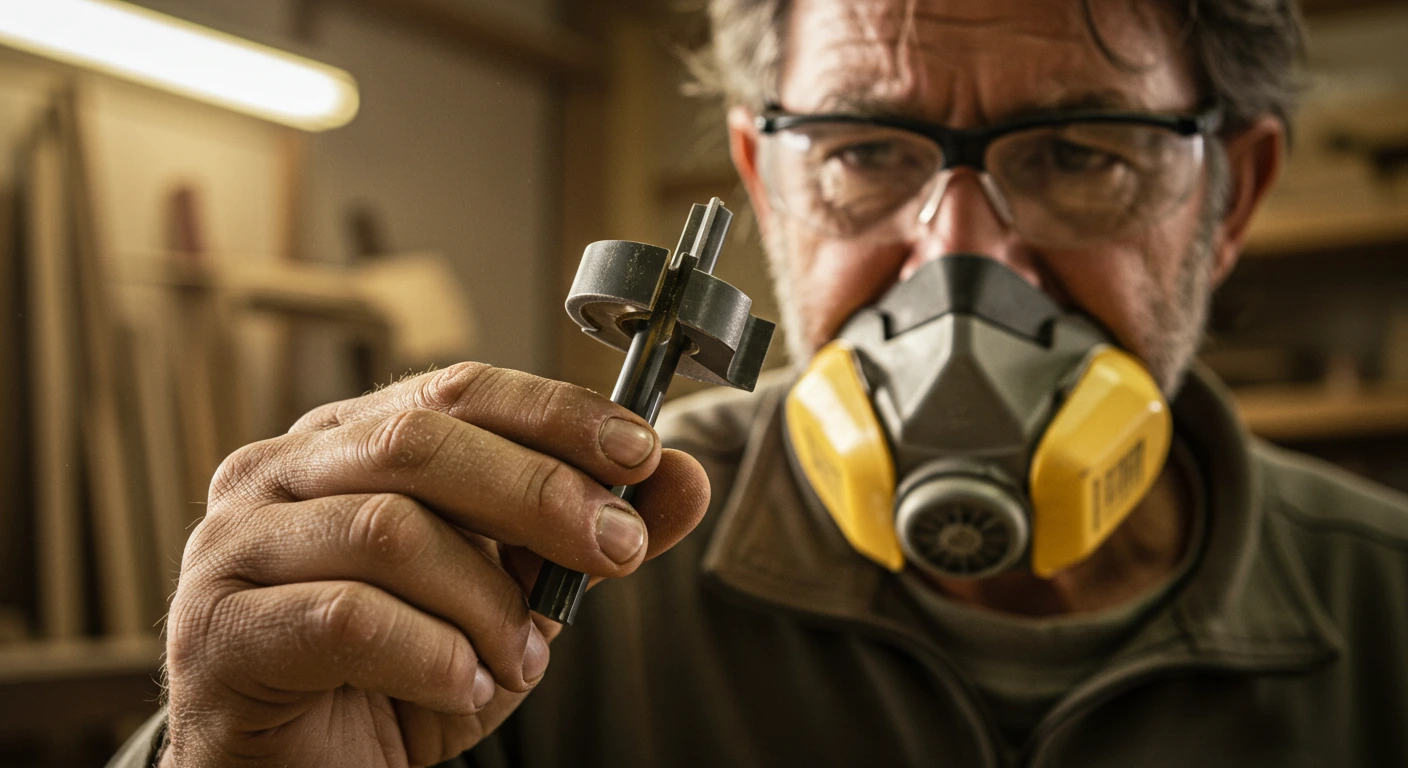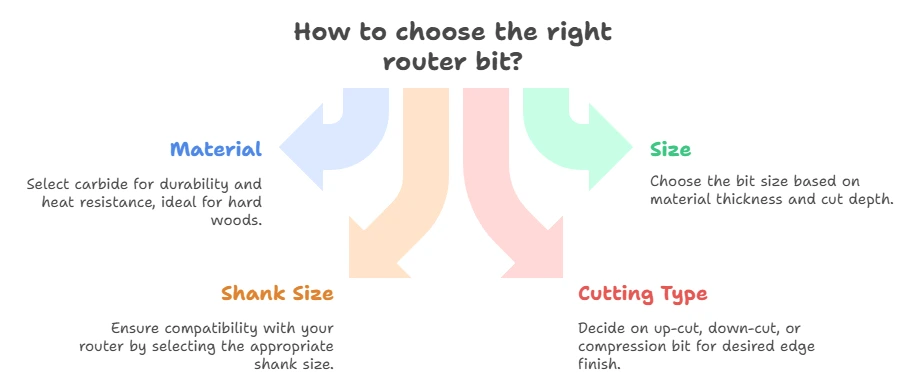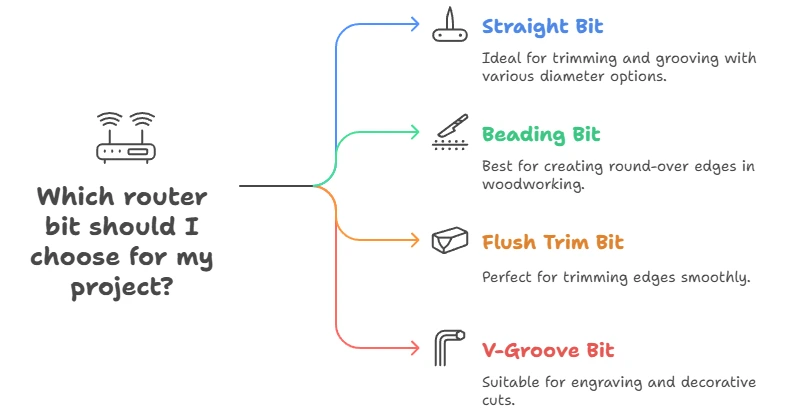
Choosing the right router bits for your projects is essential for achieving the best results. Router bits come in various shapes and sizes, each designed for specific tasks. Understanding the importance of selecting the appropriate router bit can make a significant difference in the quality of your work. Router bits are cutting tools that fit onto a router, a device used to hollow out or shape materials like wood or plastic. There are several factors to consider when selecting router bits, including the bit material, profile, and size. These elements will affect not only the finish of your project but also the efficiency of your work.
Material Matters
Router bits are made from different materials, which affect their durability and performance. Here are the most common materials:
| Material | Durability | Uses |
|---|---|---|
| High-Speed Steel (HSS) | Moderate | BASIC wood projects |
| Carbide-Tipped | High | FREQUENT use on hardwoods |
| Solid Carbide | Very High | PROFESSIONAL settings |
For occasional use, high-speed steel bits may suffice. However, if you’re working on more robust materials or doing frequent projects, investing in carbide-tipped or solid carbide bits will save you time and money in the long run.
Size and Compatibility
It’s important to choose a router bit size that works with your router model. Most routers come with specific collet sizes, and you need to ensure that the bits you select will fit. Common collet sizes include:
- 1/4 inch
- 1/2 inch
Pairing the correct bit size with your router ensures both safety and efficiency. Using the wrong size can lead to subpar results or even dangerous situations while operating the router.
Quality and Branding
The quality of router bits can greatly affect your project’s outcome. Investing in reputable brands can lead to better performance and durability. Some highly recommended brands for router bits include:
Before purchasing, read reviews and gather information about the brand’s reputation. This will help ensure you get value for your money and reduce the chance of dissatisfaction.
When selecting router bits, remember that the right choice can enhance your woodworking projects significantly. By considering the types, materials, sizes, and quality, you’ll be better equipped to achieve the results you desire. Ultimately, every project requires the right tools to succeed. By paying attention to these details when choosing your router bits, you set yourself up for successful and enjoyable woodworking experiences.
Exploring Different Types of Router Bits and Their Uses
When it comes to woodworking, the right tools can make all the difference. One essential tool in any woodworker’s arsenal is router bits. Understanding the different types of router bits and their specific uses can help you achieve precision and creativity in your projects. This guide will explore various router bits you might encounter and how they can enhance your woodworking experience.
Types of Router Bits

Router bits come in a variety of shapes and sizes, designed for different purposes. Here’s a closer look at some of the most common types:
- Straight Bits: These bits are primarily used for cutting straight edges and grooves. Their flat, straight cutting edges allow for precise cuts, making them ideal for creating dados and rabbets.
- Flush Trim Bits: Used for trimming or shaping edges, flush trim bits have a bearing that rides against the material. This allows you to shape one piece of wood to match another exactly.
- Chamfer Bits: Chamfer bits are designed to bevel the edges of a piece, creating a stylish appearance. They are ideal for softening sharp edges or creating decorative profiles.
- Roundover Bits: These bits create a rounded edge on your workpieces, making them great for adding a soft touch to furniture edges or finishing pieces that will be handled frequently.
- V-Groove Bits: Perfect for creating decorative grooves and patterns, V-groove bits have a “V” shape and can be used for engraving designs into wood surfaces.
- Panel Bits: These are specialized bits used to create raised panels for cabinet doors. They provide a decorative edge, enhancing the visual appeal of furniture.
Choosing the Right Router Bit
When selecting a router bit, consider the following factors to ensure you choose the right one for your project:
| Factor | Description |
|---|---|
| Material | Different materials like carbide, high-speed steel, or cobalt are used in router bits. Carbide bits are more durable and heat-resistant, making them a preferred choice for hard woods. |
| Size | Bits come in various diameters and cutting lengths. Choose a size that best fits the thickness of your material and the depth of cut needed. |
| Shank Size | Router bits typically come with either a 1/4-inch or 1/2-inch shank. Consider your router compatibility when selecting a bit. |
| Cutting Type | Decide whether you need a up-cut, down-cut, or compression bit depending on the finish you desire on the top and bottom edges of your cuts. |
Maintaining Your Router Bits
Proper maintenance of your router bits will ensure their longevity and effectiveness. Here are some tips to keep them in top condition:
- Clean Regularly: After each use, clean your bits with a soft brush or cloth to remove debris and resin build-up.
- Store Correctly: Keep your bits in a protective case to prevent damage and keep them organized.
- Sharpen Periodically: Dull bits can lead to poor performance. Use a sharpening tool or take them to a professional to keep them sharp.
Investing in quality router bits not only helps you create stunning projects but also saves you time and effort. For more detailed information on router bits, check out resources like Wood Magazine or Popular Woodworking.
In the world of woodworking, router bits play a crucial role in achieving clean, professional results. Familiarizing yourself with the different types of router bits and their applications will enable you to tackle a wide array of projects, from simple repairs to intricate designs. Select, maintain, and use your router bits effectively to elevate your woodworking skills and craftsmanship.
How to Maintain and Care for Your Router Bits
Proper care and maintenance of your router bits can significantly extend their lifespan, improve performance, and ensure safety while working on your projects. Here are essential tips that will help you keep your router bits in top condition, enabling you to achieve the best results possible.
Regular Cleaning
After each use, it’s crucial to clean your router bits thoroughly. Dirt and resin can build up and affect their performance. Here’s a simple cleaning procedure:
- Use a soft bristle brush to remove wood chips and dust.
- Soak the bits in a solution of warm water and mild detergent for about 10-15 minutes.
- Gently scrub with the brush again to remove stubborn residue.
- Rinse and dry completely to prevent rust.
For heavy resin buildup, consider using a dedicated router bit cleaner, which can be effective in restoring their sharpness.
Inspecting for Damage
Check your router bits regularly for any signs of damage, such as nicks or dull edges. If you notice any issues, it may be time to sharpen or replace the bit. Sharp bits are essential for achieving clean cuts and reducing the risk of kickback.
Quick tips for inspecting your router bits:
- Examine the cutting edges closely under good lighting.
- Run your fingers along the edges to feel for rough spots or damage.
- Look for signs of wear, such as discoloration or chipping.
Sharpening Your Router Bits
Keeping your router bits sharp is vital for precision and safety. When you feel they are not cutting as efficiently, it’s time to sharpen them. Here are some options:
- Professional sharpening: Take your bits to a local tool sharpening service. They have the right equipment to get them back in shape.
- Manual sharpening: You can use a sharpening stone or a dedicated bit sharpener. Just make sure to maintain the original angle while sharpening.
Regularly scheduled sharpening based on usage can help maintain peak performance.
Proper Storage
How you store your router bits is almost as important as how you maintain them. Incorrect storage can lead to unnecessary damage. Follow these storage tips:
- Store bits in a protective case to prevent them from getting nicked or dulled.
- Keep them organized by type and size to avoid confusion and simplify selection during projects.
- Use foam or wooden holders to keep cutting edges intact.
Using the Right Speed and Feed Rate
The speed at which you operate your router can significantly impact the longevity of your bits. Always refer to the manufacturer’s recommendations for the appropriate speed and feed rate. If you’re unsure, start with a lower speed and increase as needed. Gentle use will prevent overheating and excessive wear on the tips of your bits.
Preventing Rust
Rust can be a significant enemy to your router bits. Here are preventative measures:
- After cleaning, wipe the bits with a light coat of oil to create a protective barrier.
- Store bits in a dry environment; consider using silica gel packs in storage containers to absorb moisture.
- Avoid prolonged exposure to humidity whenever possible.
Choosing Quality Router Bits
Investing in high-quality router bits pays off in terms of durability and performance. Look for bits made from solid carbide, as they tend to last longer and offer better cutting abilities. High-speed steel bits are a good alternative for occasional use, but replace them if they show signs of wear.
Websites like Woodcraft and Rockler offer a variety of quality router bits to suit any need.
Maintaining your router bits is essential for producing quality work in your woodworking or carpentry projects. By following these simple tips, you can ensure that your bits remain sharp and effective, allowing you to tackle any job with confidence.
| Action | Frequency |
|---|---|
| Clean Router Bits | After Each Use |
| Inspect for Damage | Weekly or Biweekly |
| Sharpen Router Bits | As Needed |
| Store Properly | After Each Use |
| Apply Protective Oil | After Cleaning |

By implementing these maintenance strategies, you can maximize the performance of your router bits and ensure that they serve you well for many projects to come.
Tips for Achieving Smooth Cuts with Router Bits
When working with router bits, achieving smooth cuts can significantly enhance the quality of your woodworking projects. Whether you are a hobbyist or a seasoned professional, mastering the following tips can elevate your craftsmanship.
Select the Right Router Bits
The first step in getting clean cuts is choosing the right router bits for your tasks. Different bits serve various functions, so you need to understand what each one does.
- Straight Bits: Ideal for trimming edges and making grooves.
- Round-over Bits: They help in softening sharp edges for a polished look.
- Flush Trim Bits: Perfect for cutting down to the same height as another surface.
By selecting the appropriate router bit, you set yourself up for success from the start.
Ensure Sharpness of Your Bits
Using dull router bits will lead to rough cuts and can even damage your materials. Always ensure that your bits are well-maintained. Here are ways to keep your router bits sharp:
- Regularly inspect bits for wear and tear.
- Sharpen bits if they show signs of dullness.
- Use a bit cleaner to remove pitch and debris.
Keeping your bits sharp not only provides smoother cuts but also prolongs their lifespan.
Set Up Your Router Properly
Next, a properly set-up router plays a crucial role in achieving smooth cuts. Here are some setup tips:
- Correct Speed: Adjust the router speed based on the size and type of bit. Larger bits require slower speeds.
- Depth of Cut: Make shallow passes rather than trying to cut deeply in one go.
- Router Orientation: Ensure that you feed the material into the bit in the correct direction. Generally, you should move against the rotation of the bit for the cleanest finish.
Work with the Right Material
The type of material you are cutting also impacts the smoothness of your cut. Softwoods generally yield smoother cuts compared to hardwoods. To assist in cutting smoother, consider:
- Using well-seasoned wood to minimize warping.
- Avoiding knots in the wood, as they can interrupt the cutting process.
- Choosing engineered wood materials, such as plywood or MDF, for cleaner cuts.
Use Proper Feeding Techniques
Your feeding technique is crucial for achieving even and smooth cuts. Here are some useful techniques:
- Steady Pace: Maintain a constant speed as you move the material through the router.
- Pacing: Do not rush through the process; let the bit do the work.
- Push vs Pull: Depending on your router style, decide whether it makes more sense to push or pull your material across the bit.
Practice Makes Perfect
Practice with your router bits on scrap pieces of wood before tackling your main project. This helps you understand how different settings and techniques impact the smoothness of your cuts.
By following these guidelines, you can ensure that your router bits yield clean, smooth cuts every time. Mastery of your tools and techniques contributes significantly to the overall quality of your woodworking.
For more information about router bits and woodworking tips, check out Wood Magazine or Woodworkers Source.
The Role of Router Bits in Woodworking and Craftsmanship
Router bits play an essential role in woodworking and craftsmanship, enabling you to shape wood in various styles and forms. Understanding these tools can greatly enhance your woodworking projects. Whether you’re a novice or a seasoned pro, selecting the right router bit is crucial for achieving accurate and impressive results.
Choosing the Right Router Bit
Selecting the correct router bit can make a difference in the quality of your work. Here are a few factors to consider:
- Material: Ensure you get bits designed for the type of wood you are using.
- Size: The diameter affects the depth of the cut and the look of your project.
- Coating: Bits with special coatings tend to last longer and perform better.
Router Bit Specifications
Understanding the specifications of router bits helps in making informed choices. Here’s a small reference table:
| Type of Bit | Common Uses | Typical Diameter |
|---|---|---|
| Straight Bit | Trimming, grooving | 1/4″, 3/8″, 1/2″ |
| Beading Bit | Create round-over edges | 1/4″, 1/2″ |
| Flush Trim Bit | Trimming edges | 1/4″, 1/2″ |
| V-Groove Bit | Engraving, decorative cuts | 1/4″, 3/8″ |
Proper Use and Maintenance
To ensure longevity and optimal performance, proper use and care of your router bits are vital:
- Use the Right Speed: Match the router speed to the material and bit size.
- Clean Regularly: Remove resin and debris after each use to maintain sharpness.
- Store Properly: Keep bits in a protective case or holder to avoid damage.
Applications in Woodworking
The versatility of router bits allows for a diverse range of applications in woodworking. You can create beautiful edge profiles, intricate joints, or unique designs. They are ideal for:
- Cabinet making
- Crown molding
- Furniture design
- Sign making
By mastering the use of router bits, you can greatly enhance your creative capabilities in any woodworking project. Many artisans find that having a varied selection of bits allows them to explore new designs and techniques, pushing the limits of their craftsmanship.
For more information about router bits and woodworking, you can visit Wood Magazine or Woodcraft. These resources offer expert tips and a wealth of information about tools, including router bits, ensuring you stay informed in your woodworking journey.
Utilizing the right router bits can significantly change the way you approach your woodworking tasks. By investing a little time in understanding them, you’ll not only enhance your craftsmanship but also enjoy the process of creating beautiful wood projects.
Conclusion
Selecting the right router bits is crucial for the success of any woodworking project. Understanding the different types of router bits and their specific applications empowers you to choose the perfect tools for your needs, whether you’re edge forming, grooving, or creating intricate designs.
Consistent maintenance and care for your router bits will extend their lifespan and enhance their performance. Regular cleaning, proper storage, and occasional sharpening can vastly improve cut quality, ensuring that your projects turn out as envisioned. When you’re aiming for precision and elegance in your work, employing techniques for smooth cuts will set the foundation for a professional finish. Fine-tuning your router’s speed and feed rate, coupled with the correct choice of bit, can significantly elevate the quality of your craftsmanship.
The role of router bits in woodworking cannot be understated. They transform ordinary materials into stunning creations, giving life to ideas through detailed designs and perfect finishes. By mastering the art of using router bits, you elevate your skills and broaden your creative possibilities.
Ultimately, investing time in understanding and working with router bits allows you to become more proficient in woodworking. This not only enhances the quality of your projects but also increases your enjoyment and confidence as a craftsman. Each bit is a step closer to mastering the beautiful craft of woodworking. So, embrace the journey, explore the various options available, and watch your creations take shape with precision and grace.

